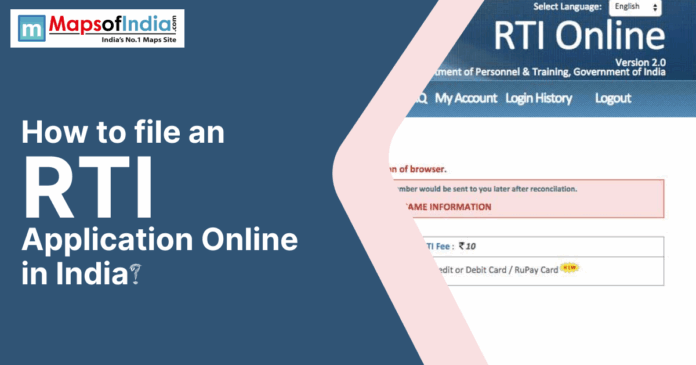The government of India brought the Right to Information Act in 2005 to empower citizens. Through this, citizens are allowed access to government records. Filing RTI online is a convenient and efficient process. Over 3 million RTI applications are filed annually from different parts of India. According to the Central Information Commission report, among those RTI applications 75% are online. The process of filing RTI is user-friendly via rtionline.gov.in. This act promotes transparency and accountability of government officials. This act covers public authorities across India. If the Private entities are not government-funded funded then they are exempt. Understanding RTI is key to effective use.
Understanding the Right to Information Act 2005
The RTI Act was brought into implementation on October 12 2005. This act replaced the Freedom of Information Act 2002. According to the Ministry of Personnel report, this act was brought to curb corruption. In the Constitution, Section 2(j) defines the right to information. It includes inspection of records and obtaining copies. When an RTI is filed, public authorities must respond to that request within 30 days. Sensitive information is not provided, which is exempt under Section 8. According to the CIC annual report, more than 10% RTIs were rejected due to exemptions. This act is applicable to the central and state governments. This act includes NGOs substantially funded by the government. Citizens can demand information on decisions and funds. This law fosters democratic participation. The act has led to over 25 million applications since it was started. RTI helps to strengthen governance.
Eligibility Criteria for Filing RTI
Any Indian citizen can file an RTI for any institution. There is no need for any specific reason. According to the RTI Online portal guide, NRIs can file through any Indian address. Foreigners are ineligible to file RTI. Minors can also file RTI via guardians. If you are applying, your age must be above 18 for independent filing. To file an RTI, there is no educational or income criterion that applies. Public authorities include ministries and PSUs. According to the CIC report, 80% applications are from urban areas. Eligibility is broad to promote access. Government agencies like IB are excluded from coverage for security reasons. Section 24 lists exemptions. Eligibility ensures democratic transparency.
Information That Can Be Sought Under RTI
RTI allows common citizens to ask queries about government functions. Citizens can ask about policies and expenditures. You can obtain details on tenders and contracts. We can also ask for exam answer sheets under Section 2(f). A Supreme Court judgment in 2024 allowed this. Personal information of anyone is restricted unless public interest. As per the CIC ruling of 2023, the salary details of private employees can’t be disclosed. To obtain third-party information, you need their consent. Cabinet papers are exempt during decision-making. A recent amendment to the RTI Act clarifies this. Commercial secrets are also protected from this. Information over 20 years old is accessible to everyone. According to the Legal India report, 90% queries are on public funds. RTI covers vast governmental aspects.
Documents Required for Online Filing
To file the RTI, we require a few documents. On the online portal, you need to provide identity proof like Aadhaar or Voter ID. On the portal, you can upload scanned copies for verification. To file an RTI, you need to pay a fee of Rs 10, but if BPL applicants submit a ration card, for a fee waiver. To register on the online portal Email ID and a mobile number are mandatory. If you want an exemption from the fee, upload proof online. PAN can also be used as an alternative ID. There is no need for affidavits or stamps. Digital signatures are optional. A CIC report says 95% filings are document-free. Keep the scanned document size under 1MB for uploads. This simplifies the process.
Step-by-Step Process to File RTI Online
Filing RTI online is a straightforward process. You need to visit the online portal called rtionline.gov.in. Click on Submit Request. Register on that site with your email and mobile number. Verify OTP sent to phone. Log in with credentials. Select the Ministry or Department for which you are filing the RTI. Enter what query you have in up to 500 characters. Upload supporting documents if required. Pay a Rs. 10 nominal fee via net banking or card. Submit and note the application number. You will receive a confirmation email when the request is submitted. Track the status of your request on the portal. Responses will come to you within 30 days. This digital method saves time.
Timelines and Response Mechanisms
For the field, RTI Public Information Officers need to respond in 30 days. If the response to the filed RTI is delayed, that will cost a Rs. 250 daily penalty. Responses to your request can come via post or email. A 2023 CIC ruling mandates digital replies. If the applicant is unsatisfied with the answers, allow a first appeal within 30 days. You can do a second appeal to CIC in 90 days. Track your RTI request via the portal with the application number. In the responses, you can receive information or rejection reasons. This ensures accountability.
Common Challenges in Filing RTI
The applicant faced many common challenges while filing for the RTI. The small queries can lead to rejections. According to the Legal India report, 20% applications are unclear. PIOs delay responses. Some applicants misuse exemptions under Section 8. According to the report of the Transparency International article, it has been noted that 10% wrongful denials. Language barriers exist in non-English-speaking states. During the peak horse glitch can occur on the online portal. An India Today article says server issues affect 5% users. Appeals take months. A CIC report says 50000 pending cases. These challenges test persistence.
Tips for Successful RTI Applications
To achieve a successful response to your application, you need to be ready with the necessary documents. Applicants need to craft their queries properly. Specify document names. Use simple language for it. Avoid adding your opinions to the queries. Research PIOs on the portal. File RTI with the correct authority. If you want to receive complex information, file multiple RTIs. Pay fees correctly. Track applications weekly to see the progress. Appeal if you are unsatisfied with the response. An India Today article says 40% appeals succeed. Use the second appeal wisely. These tips ensure effective filing.





